This post explains how to add a custom color for taskbar in Windows 11/10. The default settings in Windows impart black color to the taskbar, Action Center, and even the Start menu of the interface, but that doesn’t limit the scope of a user to change it to the color of his choice. The latest version of the OS houses multiple options and different settings to customize the taskbar and the Start menu in Windows.
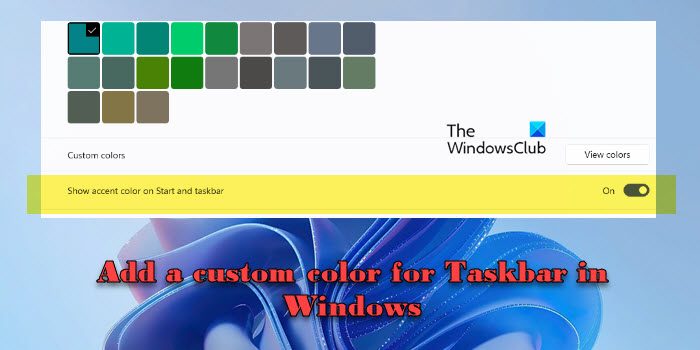
Add custom color for Taskbar in Windows 11/10
Steps to add custom color for taskbar in Windows 11 and Windows 10 differ slightly.
For Windows 10
Open the Windows Settings app. From the menu, select the ‘Personalization’ tile and choose the ‘Colors’ option on the left.
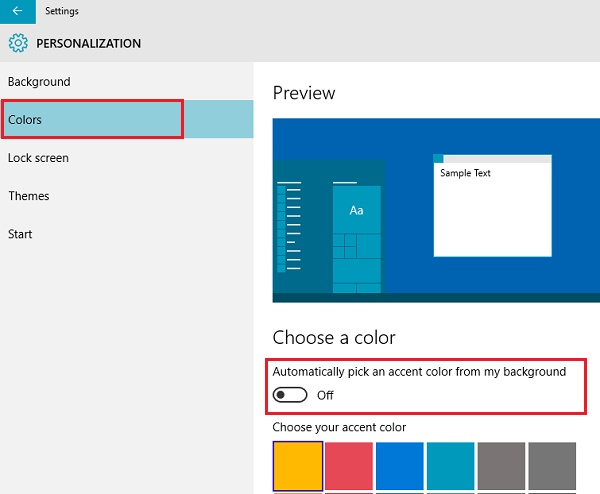
Then, look for the option ‘Automatically pick an accent color from my background’. If the option is enabled, disable it to acquire the ability to control colors for the taskbar and other appearance elements.
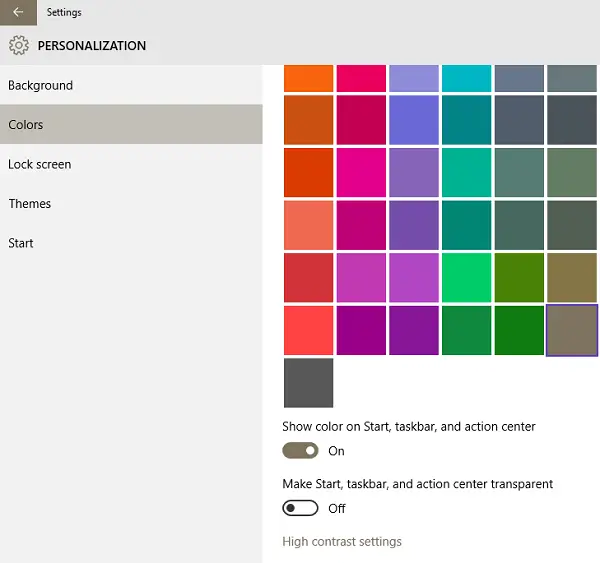
Keep scrolling down, until you find the last color box. This is the box that allows customization by the user.
To proceed further, enable the option ‘Show color on Start, taskbar, and action Center’ and select one of the predefined colors as the current color, ignoring the last box. Close the Settings app one you’re done.
For Windows 11
Press Win + I to open the Settings app. Navigate to Personalization > Colors.
Under Choose your mode, select either ‘Dark’ or ‘Custom’. If you choose ‘Custom’, select ‘Dark’ under Choose your default Windows mode.
Next, scroll down to the Accent colors section and select Manual in the dropdown next to the option. Choose your preferred accent color from the palette or click the View colors button to pick a custom color.
Scroll down further and turn on the toggle next to find the ‘Show accent color on Start and taskbar‘ option.
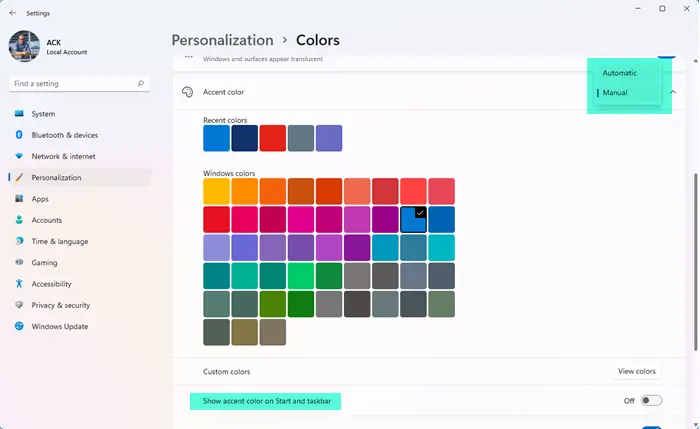
Show accent color on Start and taskbar option is grayed out
If the ‘Show accent color on Start and taskbar’ option is grayed out in the Settings window on Windows 11, it is possible that your color mode settings are not set to allow this option. To fix this, ensure you’ve followed the above steps in sequence. If the issue persists, you may enable the accent color on the taskbar using the Registry Editor.
Be sure to back up your registry before making any changes to avoid potential system issues.
Open the registry editor. To do so, press Win key +R in combination.
In the Run dialog box that appears, type ‘regedit’ and hit Enter. Navigate to the following path:
HKEY_CURRENT_USER\SOFTWARE\Microsoft\Windows\CurrentVersion\Themes\Personalize
In the right panel, double-click on ColorPrevalence and set its Value data to 1. If the value doesn’t exist, create a new DWORD (32-bit) Value named ColorPrevalence.
For changes to take effect, press Ctrl + Shift + Esc to open Task Manager. Find and select Windows Explorer in the list of processes and select Restart task in the top-right corner.
Once accent color is enabled for the taskbar, you may modify the registry values to customize the taskbar color beyond the settings provided in the standard Windows interface. To do so, look for a 32-bit DWORD value SpecialColor. In Windows 10 it already has a value data.
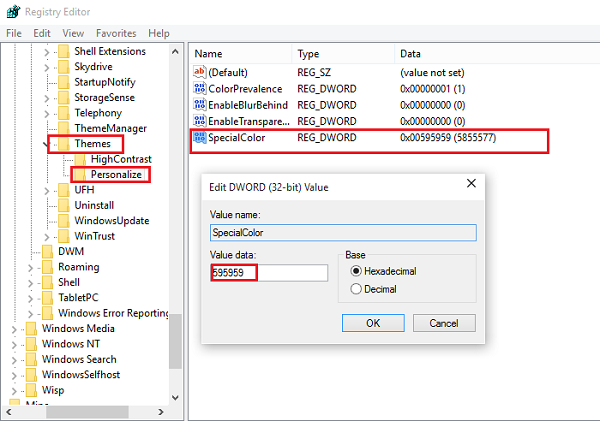
This value is a color in Alpha, Blue, Green, Red color, abbreviated from ABGR format.
You can enter the value to specify your own custom color. For example, here, I have set a gray color by changing the SpecialColor value data to grey (the value is 00bab4ab).![]()
![]()
Restart your computer and you will see the changes take effect.
More tips here on how to customize Windows taskbar.
Can I change the color of the Windows 11 taskbar?
Yes, you can change the color of the taskbar on your Windows 11 PC through the Settings app. The taskbar color is linked to the system’s accent color, which can be customized to match your preferences. However, the change depends on the settings being properly configured and there might be instances where options are grayed out due to specific system configurations or limitations. Advanced users can also modify registry settings to achieve more specific color customizations for the taskbar.
How do I customize the taskbar widget in Windows 11?
To customize the taskbar widgets in Windows 11, click the widgets icon (the weather icon) in the left corner of the taskbar or press Win+W. Then click the Settings icon in the top-right corner of the widgets panel and select ‘Discover new widgets‘. Install the desired widget to your widgets board, select More Options (…) in the upper-right corner of the widget, and then select Pin. Other customization options include unpinning a widget, moving or resizing a widget, and more.
Read Next: Best free Taskbar Customization software for Windows.